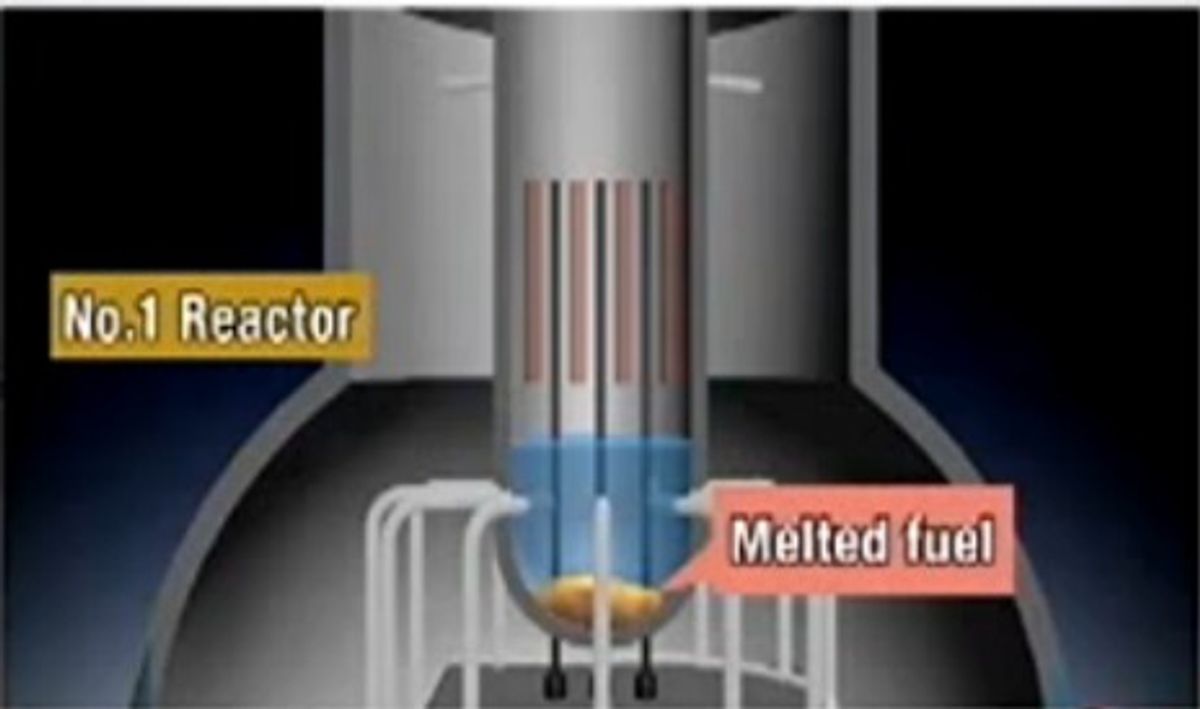Editor's Note: John Boyd is an IEEE Spectrum contributor reporting from Kawasaki, Japan. This is part of IEEE Spectrum's ongoing coverage of Japan's earthquake and nuclear emergency. For more details on how Fukushima Dai-1's nuclear reactors work and what has gone wrong so far, see our explainer.
The nuclear fuel rods in the No. 1 reactor of the crippled Fukushima nuclear power plant reactor have suffered at least a partial meltdown, Tokyo Electric Power Co. (TEPCO) announced yesterday.
The discovery brought plans to flood the No. 1 reactor's containment vessel—a preliminary step to installing a new cooling system for the damaged reactor—to an untimely halt. A government minister said the situation was serious enough that TEPCO's "roadmap," the schedule that aims to bring the plant to a cold shutdown in less than nine months, would have to be reviewed.
TEPCO apparently learned about the meltdown early on Thursday. Workers had gone into the No. 1 reactor building earlier this week to adjust a water gauge in the reactor vessel and other instruments; the resulting data showed that the water level in the reactor vessel had fallen below the fuel rods leaving them at least partially exposed.
A TEPCO official told the press on Thursday that its seems likely the fuel rods have at least partially melted “and fallen to the bottom of the reactor. So it can be said the No. 1 reactor is a state of meltdown.”
The good news is that there appears to have been enough water at the bottom of the reactor's pressure vessel to cool the molten fuel, given that the temperature remains relatively stable between 100 degrees C and 120 degrees C.
The bad news is that TEPCO suspects that the molten fuel damaged the bottom of the reactor pressure vessel, allowing radioactive water to leak out of the pressure vessel and into the building. This scenario would explain the high radiation levels that have been measured in different parts of the reactor building, despite the use of air-filtering equipment that was meant to decontaminate the air and bring down radiation levels before workers entered the building on Monday to survey the situation.
Banri Kaieda, head of the Ministry of Economy, Trade and Industry, told reporters that the meltdown was sufficiently serious that “it will require a review of TEPCO’s schedule for bringing the plant under control.” The revised plan is to be announced on May 17.
In a press conference on Friday, Japan's chief cabinet secretary Yukio Edano said that after studying various data, including the temperature and pressure of the reactor, “we believe that when it comes to the safety and security of the residents, it does not mean that the situation has been aggravated.”
Edano added that aside from this new development there had been other developments and changes affecting the TEPCO roadmap since it was announced, so it was already being reviewed, and these latest setbacks would also have to taken into consideration. “The leakage of water (in the No. 1 reactor) is apparently much greater than was assumed. So this is one factor that will have to be born in mind (in reviewing the schedule). And they have not identified the cause of the leakage yet. So they will have to investigate it properly and take whatever action is needed.”
TEPCO is reported to have injected some 10 000 tons of water in total into the containment vessel and the pressure vessel of the No. 1 reactor since March, yet the pressure vessel apparently remains less than half full. And while radioactive water has pooled in the adjacent turbine building basement and an outside trench, the water levels have not been rising in those locations, indicating that the water is flowing elsewhere.
One possibility is that the water is leaking into the reactor building basement, which no one has entered since the accident. The company is considering sending a robot into the basement to assess the situation, but has expressed concern that radio contact with the robot could be lost as it makes its way farther into basement.





